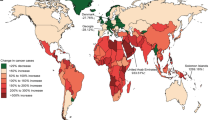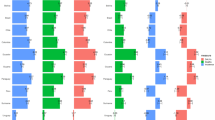Abstract
Information diffusion methods (IDMs) often deal with “small sample problems” and distribute the information of one data point to its neighbors in fuzzy information processing. By considering new criteria, we establish an optimal model for parameters of IDMs to risk and decision analysis of fatal disease. We further illustrate a specific process and a successful application of IDMs by a more reasonable morbidity surface from one-dimensional and two-dimensional case studies of breast cancer analysis in Yanpu District, Shanghai.






Similar content being viewed by others
References
Banatre M, Becus M, Couderc P (2008) Ubi-board: a smart information diffusion system. NEW2AN 2008, LNCS 5174, pp 318–329
Cummins JD, Derrig RA (1993) Fuzzy trends in property-liability insurance claim costs. J Risk Insur 60:429–465
Cummins JD, Derrig RA (1997) Fuzzy financial pricing of property-liability insurance. N Am Actuar J 1:21–40
DeWit GW (1982) Underwriting and uncertainty. Insur Math Econ 1:277–285
Di Penta M, Lombardi P, Taneja K, Troiano L (2008) Search-based inference of dialect grammars. Soft Comput 12(1):51–66
Dunis C (1996) Forecasting financial markets: exchange rates, interest rates and asset management. Wiley, New York
Goguen JA (1967) L-fuzzy sets. J Math Anal Appl 18:145–174
Horgby P, Lohse R, Sittaro N (1997) Fuzzy underwriting: an application of fuzzy logic to medical underwriting. J Actuar Pract 5(1):79
Huang CF (1997) Principle of information diffusion. Fuzzy Sets Syst 91(1):69–90
Huang CF, Shi Y (2002) Towards efficient fuzzy information processing. Physica-Verlage, Heidellberg
Jablonowski M (1997) Modeling imperfect knowledge in risk management and insurance. Risk Manage Insur Rev 1(1):98
Klir GJ, Folger TA (1988) Fuzzy sets, uncertainty, and information. Prentice Hall, Englewood Cliffs
Lemaire J (1990) Fuzzy insurance. ASTIN Bull 20(1):33–55
Ohand KW, Bandler W (1987) Properties of fuzzy implication operators. Int J Approx Reason 1:253–283
Ostaszewski K (1993) Fuzzy set methods in actuarial science. Society of Actuaries, Schaumburg
Otero J, Sanchez L, Alcala-Fedz J (2008) Fuzzy-genetic optimization of the parameters of a low cost system for the optical measurement of several dimensions of vehicles. Soft Comput 12(8):751–764
Post EL (1921) A general theory of elementary propositions. Am J Math 43:163–185
Puri M, Ralsescu D (1986) Fuzzy random variables. J Math Anal Appl 114:409–422
Ruan D, Huang CF (eds) (2000) Fuzzy sets and operations research for decision support: key selected papers by Hans-Jürgen Zimmermann. Beijing Normal University Press, Beijing
Shang HJ, Lu YC, Jin P (2003) Higher dimensional information diffusion and its application. Proceedings of the NAFIPS-2003 Conference, Chicago, USA
Shang HJ, Wang RM, Yang JP, Wu XY, Lu YC, Shen WX, Xie ZG (2006) Actuarial Science, theory and methodology. Higher Education Press, Beijing, and World Scientific Publishing Company, Singapore
Sheng CC, Chiu HY, Chen AP (2007) Using computational methodology to price European options with actual payoff distributions. Soft Comput 11(12):1115–1122
Szmidt E, Kacprzyk J (2001) Entropy for intuitionistic fuzzy sets. Fuzzy Sets Syst 118:467–477
Waters HR (1978) The moments and distributions of actuarial functions. J Inst Actuar 105:61–75
Young VR (1997) Adjusting indicated insurance rates: fuzzy rules that consider both experience and auxiliary data. Proceedings of the Aasualty Actuarial Society, 84, 734
Zadeh LA (1965) Fuzzy sets. Inf Control 8:338–353
Zadeh LA (1994) The role of fuzzy logic in modeling, identification and control. Model Identif Control 15(3):191
Acknowledgments
This work was supported by the National Basic Research Program of China (973 Program) under the Grant No. 2007CB814904. Authors also thank Dr. Anle Li for his help in completing this paper.
Author information
Authors and Affiliations
Corresponding author
Rights and permissions
About this article
Cite this article
Li, R., Yao, J., Shang, H. et al. An optimal model of information diffusion principles to risk and decision analysis of breast cancer morbidity. Soft Comput 14, 1297–1303 (2010). https://doi.org/10.1007/s00500-009-0498-x
Published:
Issue Date:
DOI: https://doi.org/10.1007/s00500-009-0498-x




